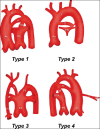Isolated persistence of the fifth aortic arch in an infant presenting with congestive heart failure
- PMID: 32030044
- PMCID: PMC6979032
- DOI: 10.4103/apc.APC_53_19
Isolated persistence of the fifth aortic arch in an infant presenting with congestive heart failure
Abstract
The persistence of the fifth aortic arch (PFAA) in postnatal life is an extremely rare and controversial cardiovascular malformation. PFAA is defined as an extra-pericardial vessel arising from the ascending aorta proximal to the origin of the brachiocephalic arteries, terminating either in the dorsal aorta or in the pulmonary arteries through the persistently patent arterial duct. An isolated PFAA with systemic-to-pulmonary connection best fits this definition, while the vast majority of cases reported as PFAA may have alternative embryological explanations. We present a unique case of a 5-week-old patient with an isolated PFAA with systemic-to-pulmonary connection, who presented with congestive heart failure. A first differential diagnosis was made with distal aortopulmonary window and an atypical patent arterial duct. A careful analysis of the case and a systematic review of the literature made us conclude for an isolated PFAA, which is one of the only five cases ever reported.
Keywords: Aortic arch anomalies; aortopulmonary window; congestive heart failure; persistence of fifth aortic arch.
Copyright: © 2019 Annals of Pediatric Cardiology.
Conflict of interest statement
There are no conflicts of interest.
Figures



References
-
- van Praagh R, van Praagh S. Persistent fifth arterial arch in man. Congenital double-lumen aortic arch. Am J Cardiol. 1969;24:279–82. - PubMed
-
- Gerlis LM, Ho SY, Anderson RH, Da Costa P. Persistent 5th aortic arch – A great pretender: Three new covert cases. Int J Cardiol. 1989;23:239–47. - PubMed
-
- Lloyd DF, Ho SY, Pushparajah K, Chakraborty S, Nasser M, Uemura H, et al. Persistent fifth aortic arch: The “great pretender” in clinical practice. Cardiol Young. 2018;28:175–81. - PubMed
-
- Freedom RM, Yoo SJ, Mikailian H, Williams WG. The Natural and Modified History of Congenital Heart Disease. New YorK, NY: Wiley-Blackwell; 2008.

